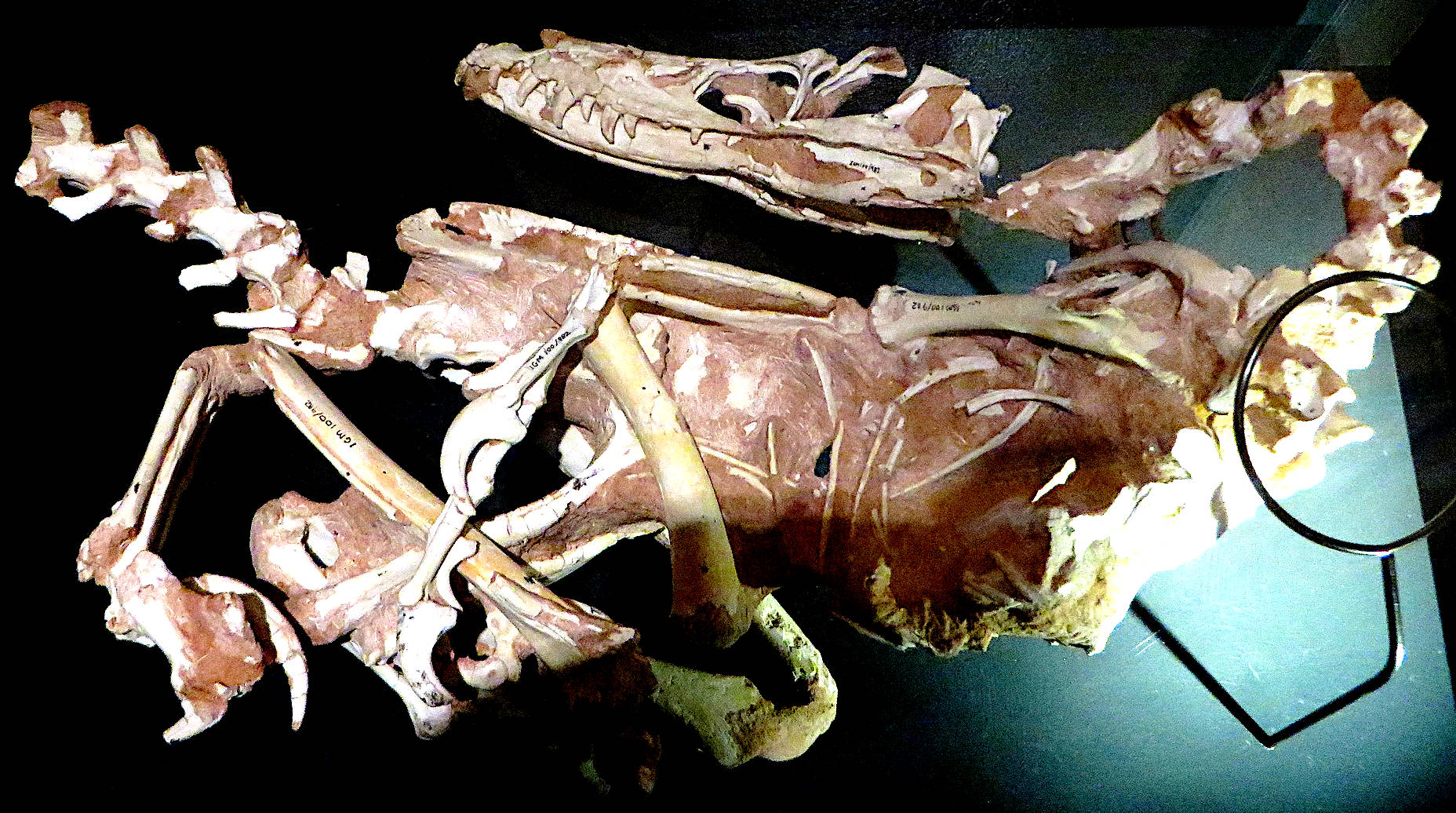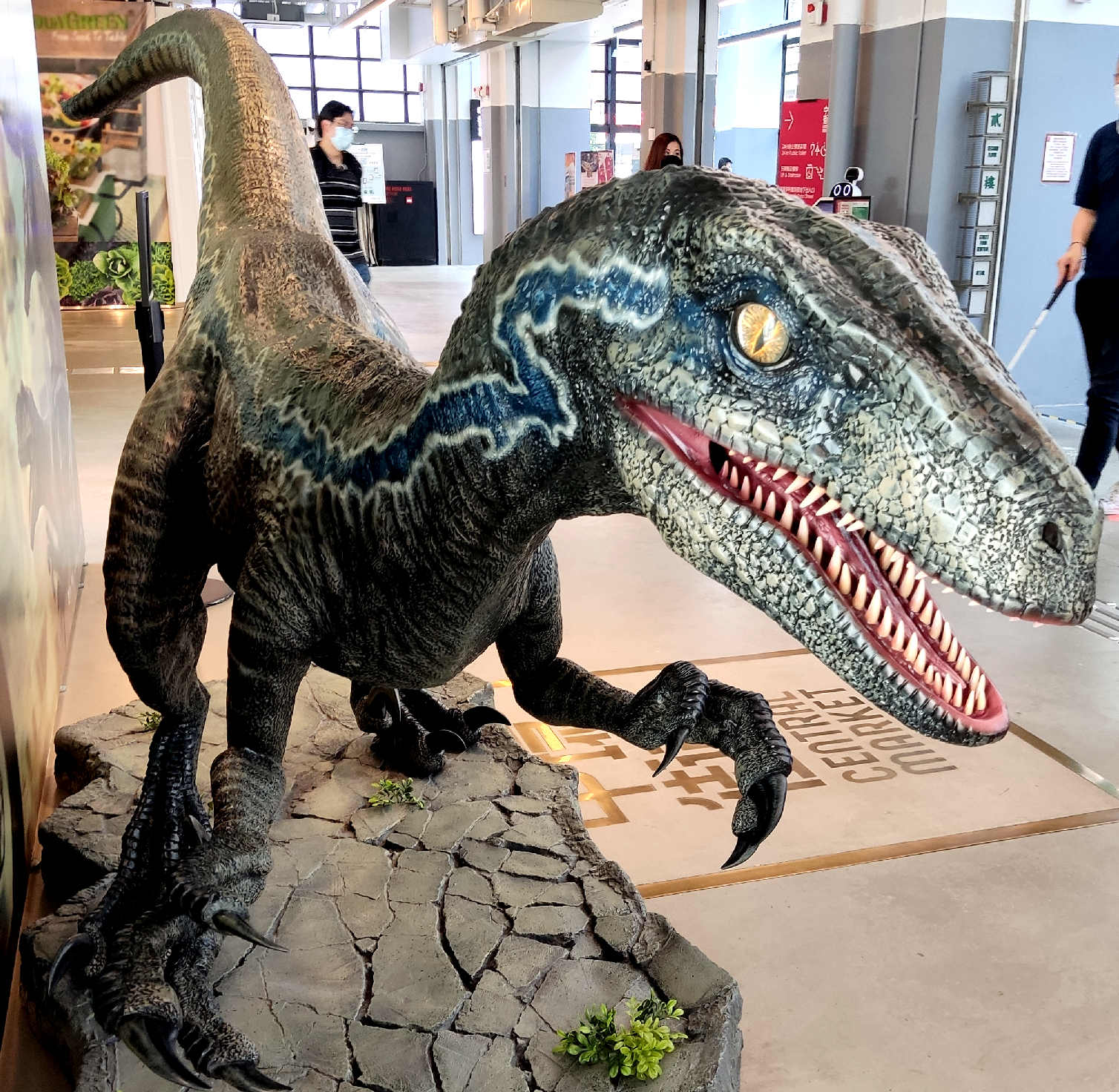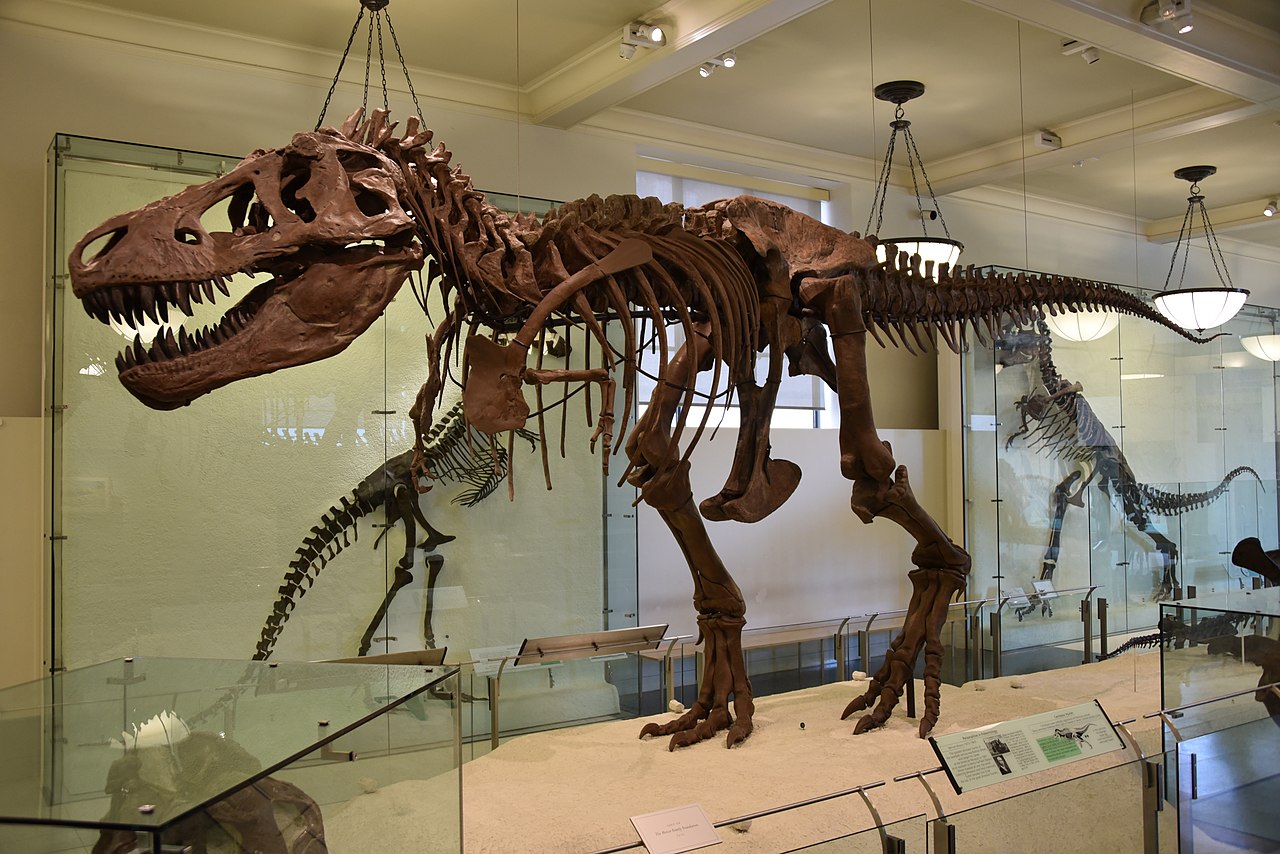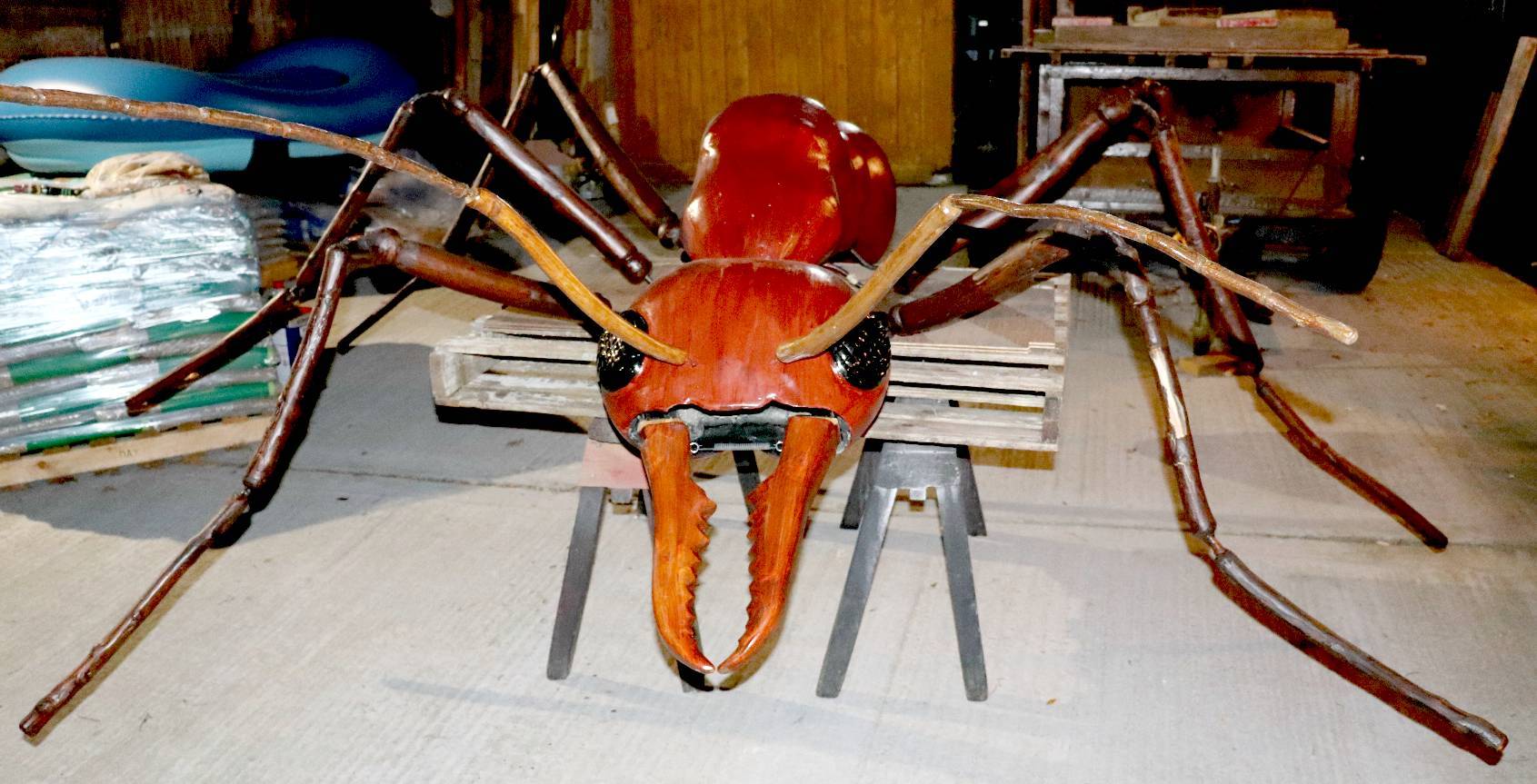
Velociraptor skeleton specimen IGM 100/982
Velociraptor ('swift thief') is a genus of small dromaeosaurid dinosaurs that lived in Asia during the Late Cretaceous epoch, about 75 million to 71 million years ago. Two species are currently recognized, although others have been assigned in the past. The type species is V. mongoliensis, named and described in 1924. Fossils of this species have been discovered in the Djadochta Formation, Mongolia. A second species, V. osmolskae, was named in 2008 for skull material from the Bayan Mandahu Formation, China.
Smaller than other dromaeosaurids like Deinonychus and Achillobator, Velociraptor was about 1.5–2.07 m (4.9–6.8 ft) long with a body mass around 14.1–19.7 kg (31–43 lb). It nevertheless shared many of the same anatomical features. It was a bipedal, feathered carnivore with a long tail and an enlarged sickle-shaped claw on each hindfoot, which is thought to have been used to tackle and restrain prey. Velociraptor can be distinguished from other dromaeosaurids by its long and low skull, with an upturned snout.
Velociraptor (commonly referred to as "raptor") is one of the dinosaur genera most familiar to the general public due to its prominent role in the Jurassic Park films. In reality, however, Velociraptor was roughly the size of a turkey, considerably smaller than the approximately 2 m (6.6 ft) tall and 90 kg (200 lb) reptiles seen in the novels and films (which were based on members of the related genus Deinonychus). Today, Velociraptor is well known to paleontologists, with over a dozen described fossil skeletons. One particularly famous specimen preserves a Velociraptor locked in combat with a Protoceratops.
DISCOVERY
During an American Museum of Natural History expedition to the Flaming Cliffs (Bayn Dzak or Bayanzag) of the Djadochta Formation, Gobi Desert, on 11 August 1923, Peter Kaisen discovered the first Velociraptor fossil known to
science - a crushed but complete skull, associated with one of the raptorial second toe claws (AMNH 6515). In 1924, museum president Henry Fairfield Osborn designated the skull and claw (which he assumed to come from the hand) as the type specimen of his new genus, Velociraptor. This name is derived from the Latin words velox ('swift') and raptor ('robber' or 'plunderer') and refers to the animal's cursorial nature and carnivorous diet. Osborn named the type species V. mongoliensis after its country of origin. Earlier that year, Osborn had informally mentioned the animal in a popular press article, under the name "Ovoraptor djadochtari" (not to be confused with the similarly named Oviraptor), eventually changed into V. mongoliensis during its formal description.
While North American teams were shut out of communist Mongolia during the Cold War, expeditions by Soviet and Polish scientists, in collaboration with Mongolian colleagues, recovered several more specimens of Velociraptor. The most famous is part of the "Fighting Dinosaurs" specimen (MPC-D 100/25; formerly IGM, GIN, or GI SPS), discovered by a Polish-Mongolian team in 1971. The fossil preserves a Velociraptor in battle against a Protoceratops. It is considered a national treasure of Mongolia, and in 2000 it was loaned to the American
Museum of Natural History in New York City for a temporary exhibition.
Between 1988 and 1990, a joint Chinese-Canadian team discovered Velociraptor remains in northern China. American scientists returned to Mongolia in 1990, and a joint Mongolian-American expedition to the Gobi, led by the American Museum of Natural History and the Mongolian Academy of Sciences, turned up several well-preserved skeletons. One such specimen, MPC-D 100/980, was nicknamed "Ichabodcraniosaurus" by Norell's team because the fairly complete specimen was found without its skull (an allusion to the Washington Irving character Ichabod Crane). While Norell and Makovicky provisionally considered it a specimen of Velociraptor mongoliensis, it was named as a new species Shri devi in 2021.
In 1999, Rinchen Barsbold and Halszka Osmólska reported a juvenile Velociraptor specimen (GIN or IGM 100/2000), represented by a complete skeleton including the skull of a young individual. It was found at the Tugriken Shireh locality of the Djadochta Formation during the context of the Mongolian-Japanese Palaeontological Expeditions. The coauthors stated that detailed descriptions of this and other specimens would be published at a later date.

'Blue,'
the Velociraptor we all love from Jurassic World
JURASSIC PARK
Velociraptor is commonly perceived as a vicious and cunning killer thanks to their portrayal in the 1990 novel Jurassic Park by Michael Crichton and its 1993 film adaptation, directed by Steven Spielberg. The "raptors" portrayed in
Jurassic Park were actually modeled after the closely related dromaeosaurid Deinonychus. Paleontologists in both the novel and film excavate a skeleton in Montana, far from the central Asian range of Velociraptor but characteristic of the Deinonychus range. Crichton met with the discoverer of Deinonychus, John Ostrom, several times at Yale University to discuss details of the animal's possible range of behaviors and appearance. Crichton at one point apologetically told Ostrom that he had decided to use the name Velociraptor in place of Deinonychus because the former name was "more dramatic." According to Ostrom, Crichton stated that the Velociraptor of the novel was based on Deinonychus in almost every detail, and that only the name had been changed. The Jurassic Park filmmakers also requested all of Ostrom's published papers on Deinonychus during production.[66] They portrayed the animals with the size, proportions, and snout shape of Deinonychus rather than Velociraptor.
Production on Jurassic Park began before the discovery of the large dromaeosaurid Utahraptor was made public in 1991, but as Jody Duncan wrote about this discovery: "Later, after we had designed and built the raptor, there was a discovery of a raptor skeleton in Utah, which they labeled 'super-slasher.' They had uncovered the largest Velociraptor to date and it measured five-and-a-half-feet tall, just like ours. So we designed it, we built it, and then they discovered it. That still boggles my mind." Spielberg's name was briefly considered for naming of the new dinosaur in exchange for funding of field work, but no agreement was reached.
Jurassic Park and its sequel The Lost World: Jurassic Park were released before the discovery that dromaeosaurs had feathers, so the Velociraptor in both films were depicted as scaled and featherless. For Jurassic Park III, the male Velociraptor was given quill-like structures along the back of the head and neck, but these structures do not resemble the feathers that Velociraptor would have had in reality due to reasons of continuity. The Jurassic World sequel trilogy ignored the feathers of Velociraptor, adhering to the designs from Jurassic Park. However, the dromaeosaur Pyroraptor was feathered for Jurassic World Dominion, along with other changes such as stiffening the tail to account for ossified tendons and de-pronating the hands.

T.
Rex - America Museum of Natural History
ALLOSAURUS
ANKYLOSAURUS
ARCHAEOPTERYX
BARYONYX
BRACHIOSAURUS
BRONTOSAURUS
CAMARASAURUS
CARNOTAURUS
CERATOSAURUS
COELOPHYSIS
DIPLODOCUS
GALLIMIMUS
IGUANODON
MEGALOSAURUS
MOSASAURUS - MEUSE LIZARD
OVIRAPTOR
PARASAUROLOPHUS
PLESIOSAURUS
PTERANODON
PTERODACTYL
RAPTOREX
SPINOSAURUS
STEGOSAURUS
STYRACOSAURUS
TRICERATOPS
TYRANNOSAURUS
REX
VELOCIRAPTOR

A
Sectasaur™ model, full size.
CHAPTERS
|
CHARACTERS
|
DINOSAURS
|
MOVIES
|
PLOT
OUTLINE





